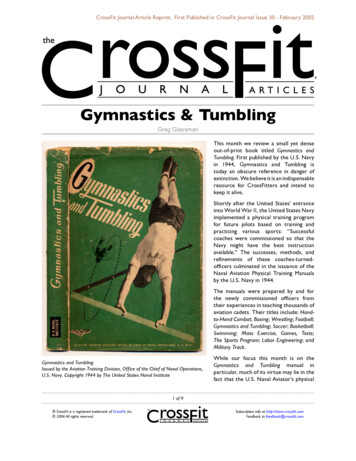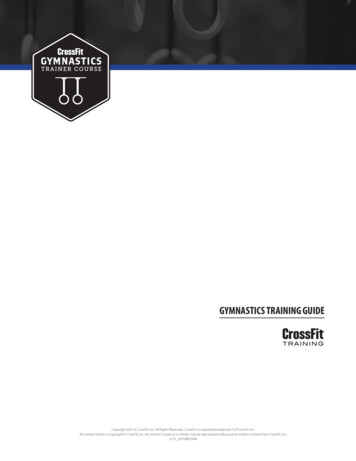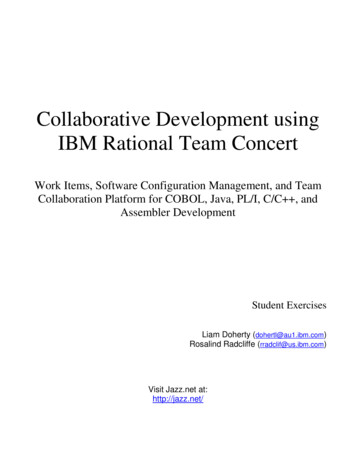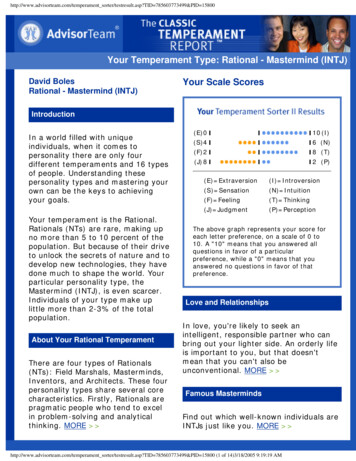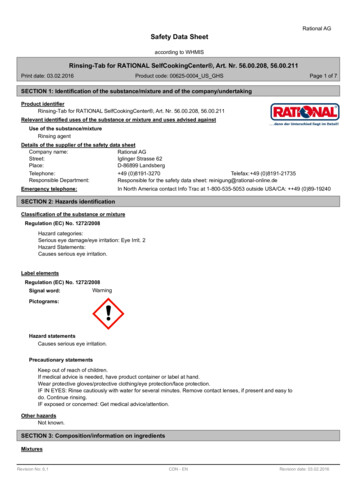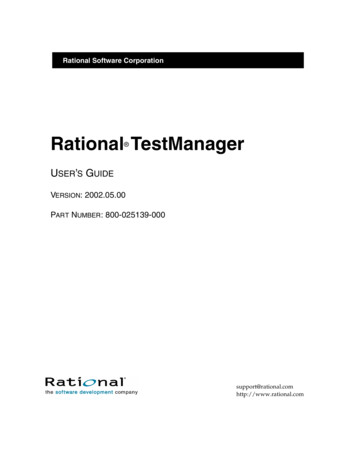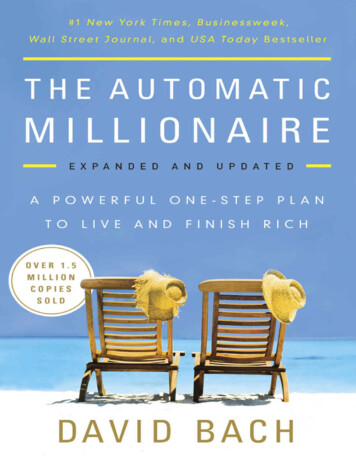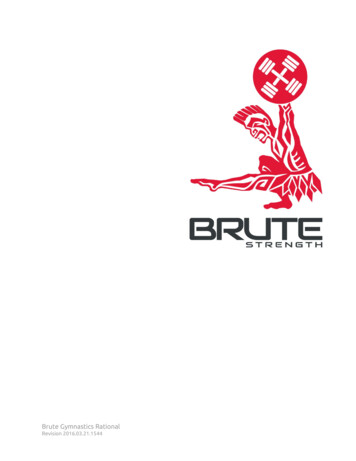
Transcription
Brute Gymnastics RationalRevision 2016.03.21.1544
Significance (asking why?)The fuel for innovation is typically demand or necessity. Countless people around the worldare seeking to find the most effective way to optimize their performance in competitivefitness, general athletics, specific sports and body aesthetics. Thus the inception of brUTEstrength has centered about assembling a team to provide expertise in fitnessprogramming. Body weight movements are utilized in virtually all areas of fitness fortraining and in competition. It followed that we create brUTE gymnastics to satisfy the specific needs of our athletes to optimize body weight movements. So the significance ofthis program for us is as simple as that. And, I would imagine that, if you are reading thisarticle, a significant need in your life exists to utilize or coach optimized body weighttraining. Everything that follows is our process of innovation that has lead to the reasoningwhy we do what we do at brUTE gymnastics. As my background is medicine, I have chosento outline this as a scientific paper. That’s just the way my brain works now, and I think it isfitting here. All of us at brUTE hope this will help you in your reasoning and utilization offitness gymnastics. But whether you follow this rational or not, we hope that you will beinspired to ask “why?” more often. As the saying attributed to Socrates goes, “I know onlythat I know nothing.”Specific AIM (defining goals)The goal of brUTE gymnastics is quite simple – we have to program to make our clientsbetter athletes by optimizing their ability to manipulate their own bodyweight. That’spretty much it. This is what has been commonly referred to in the competitive fitness worldas gymnastics our goal has to be to make our athletes “good at gymnastics.” That is theeasy part. How to do that is what gets a little tricky Background (identifying what we know)Most of us are well aware that what is called “gymnastics” in competitive fitness is a fardifferent animal than the “gymnastics” you see when you watch the superhuman featsperformed on the apparatus at the Olympics. That kind of gymnastics is called “artisticgymnastics” and it operates with a completely different set of rules and goals that don’tapply to competitive fitness. Thinking you are anything close to an artistic gymnast becauseyou learned how to do a ring muscle-up is like thinking you are Louis Armstrong becauseyou hummed out happy birthday on a kazoo. That is not to take anything away from thegreat accomplishment of learning a muscle-up. That is just us being honest with ourselves[Figure 1] .1
The ability of a high level artistic gymnast to manipulate his or her own bodyweight in spaceis unmatched in the athletic world. So it would be great if we could train all of our athletesto be highly skilled Olympic gymnasts, but the diminishing returns would be readilyapparent if we trained our athletes to perform highly specialized gymnastics skills.Although it would be cool if they could, our athletes will never need to master a standingfull on a balance beam, a back-toss on parallel bars, a Tkachev on high bar, flares on pommelhorse, etc. So training for that would be a waste of time. However, our athletes wouldcertainly benefit if they had the balance, strength, flexibility and body awareness that ittakes to perform these skills.2
We also know that the “gymnastics” movements commonly performed in competitivefitness either don’t exist in the world of artistic gymnastics or are simply training tools andnot real skills. If you ask an artistic gymnast to do a ‘kip’ on either bar or rings, you will seesomething a lot different than what competitive fitness would lend you to believe a ‘kip’ is.A muscle up is just a way to get up on the rings with no actual difficulty value and there isno such thing as a ‘kipping’ muscle up. Also, artistic gymnasts traditionally do not use thelower body to assist doing upper body strength skills such as pull-ups and handstandpush-ups (HSPU) as they are not tested for a time/work domain but rather just used to buildpure strength. So a gymnast, who has more than enough strength to do many of these‘strict,’ has no need to ‘kip.’Further, unlike artistic gymnasts, our competitive fitness athletes are not graded onaesthetic body form. They are typically only graded on range-of-motion (ROM), or thebeginning and end of a movement. What happens in the middle is at their discretion. It’slike a fitness sandwich -- you can put whatever you want in the middle of it, as long as it hasa piece of bread on both ends you can call it a sandwich. Competitive fitness athletes onlybenefit from doing a movement in the most biomechanically efficient way possible; sowhether they use straight or bent legs, pointed or flexed toes, shrugged or pressed outshoulders, etc only matters inasmuch as the form meets the ROM criteria and helps themconserve strength and cardio-respiratory effort as much as possible. In other words, itdoesn’t matter if it looks good, only if it works well.So it follows that we have entered a world of having to learn and coach skills that share acommon foundation with artistic gymnastics, but must be tested, trained and evaluated asseparate entities. When we evaluate a swinging (kipping) toe-to -bar, we don’t have theluxury of looking back at how Bela Karolyi taught Nadia Comaneci, M ary Lou Retton ,Dominique Moceanu and Kerri Strug how to do it. Instead we have to evaluate this ‘newskill’ intelligently with what we know from our experience performing the skill, as well as asound knowledge of biomechanics and physics.Whether performing body weight movements that are common to artistic gymnastics orunique for competitive fitness, most would concede that athletes with a background ingymnastics have a great advantage (to the point of it being annoying watching how wellthey perform while everyone else struggles and I get it it’s the same way I feel when Iwatch my friends who played football back squat and my legs are crumbling like they aremade of paper-mache) [Figure 2] . Our non-gymnast athletes would love to share in thisadvantage of having background in gymnastics. So to reconcile this we first got a few ofthem wasted and dumped them and some “Chernobly” energy drink in a hot tub. This didn’twork so we got a few of them up to 88 mph in a Delorean, but that didn’t work either. Sonext we envisioned creating a program to build a gymnastics foundation in our adultathletes that would mimic the way young gymnasts learn. In essence we had to find a wayto train our athletes to think and move like artistic gymnasts and not like a “crossfitter” whodoes gymnastics moves.3
Hypothesis (making assumptions about what we don’t know)When I started out coaching fitness related gymnastics, I was basically training people to‘learn moves.’ My line of thinking was something like: “How do I get people to domuscle-ups and handstand push-ups better?” So I made people do a ton of drills related tohigh-level movements along with repeatedly practicing the movements themselves. When Igot together with Mike and Matt for the precursor to brUTE strength we collectivelybecame more sophisticated by making more logical and linear progressions. I made a verylarge document which outlined numerous drills, from easiest to hardest, leading to each ofthe high level moves then interspersed these elements in the athlete training programs. Wehave been blessed to work athletes with tremendous talent and work ethic and they sawgreat results. But it drove us crazy that, despite all that, ex-gymnasts of similar absolutestrength and body type could still perform body weight movements so much better, andthat new skills were relatively hard for our athletes to learn. They weren’t as ready for the‘unknown and unknowable’ as we needed them to be. They were growing and succeeding,but we wanted them to thrive and excel beyond just being good at the skills we taughtthem to do.4
So our hypothesis became this: if we make a program that only focuses on building the basiccore foundation of an artistic gymnast in our athletes, then that foundation in itself willtranslate to superior improvement in not only higher level tested skills but also to anyunknown body weight movement that could be thrown at them. Further, we surmised thatthe optimal way to train gymnastics for purposes of competitive fitness and generalathleticism is to make athletes train just like young gymnasts do - by graduating throughand mastering lower level skills them before moving on to higher level skills. Rather thangiving our athletes a blueprint for a bird-house, we would start teaching them the skills of acarpenter. Then they could build whatever we asked them to.Methods (making a program)To ‘test our hypothesis’ we had to design a program to build our athletes’ gymnasticsabilities from the ground up. Our program would have to teach athletes to think and movelike an artistic gymnasts while functioning within the confines of their individual traininggoals. So we determined that a brUTE strength gymnastics program would have to satisfythe criteria of being: logical, linear, personalized, and incorporable [ Figure 3] .The story goes that the Greek scholar Archimedes shouted “Eureka!” when he stepped intoa bath-tub and suddenly realized the volume of water displaced must be equal to the5
volume if his body submerged. He got so excited he ran around town naked and everyonewas like “Damn Archimedes, you crazy but thanks for the discovery bro.” I had a similareureka moment when coming up with this program. I got so excited that I made anawesome spreadsheet. This admittedly is slightly less boss than running around townnaked. But it worked out well because the oppressive laws against such self-expression inSouth Louisiana would have made it less “Damn, you crazy” and more “Have you lost yourmind you stupid cajun? Get in this car right now. We are taking you to the jail.” Butanyway my moment of insight was this: Our goal at brUTE gymnastics should be to worktowards enhancing physical attributes, not learning skills. In other words, the thing we were‘progressing toward’ in our ‘progression’ needed to be excellence in the general (in themind and body), not in the specific (in the task). To elaborate I’ll tell you how I did it I made a list of all of the gymnastics movements I could think of that are tested incompetitive fitness. I thought about all of the physical body attributes it took to performthese movements and assigned subjective weighted values. For instance, a push uprequires a lot of pushing strength but not much mobility or dynamic body awareness;whereas a butterfly pull up requires no pushing strength but does require a ton of pullingstrength, mobility and dynamic body awareness. Charts and graphs were flying all over theplace in a frenzy of nerd fury (nerd level 11). What came from all of that was not crackingthe DiVinci code of fitness, but rather a keen awareness of what physical attributes brUTEstrength had to build in our athletes, and in what proportion, in order to foster growth in afoundation in gymnastics .In order to facilitate building these attributes, and keep the principle of training like agymnast, I decided that we should create and have our athletes progress through levels,just like young competitive gymnasts do. Within each level there should be skills that youhave to master to move on to the next level. And the skills within each level will bedetermined by those core physical attributes needed for success in gymnastics. Theseattributes are: (1) Dynamic movement coordination (2) Static body position awareness andstrength (3) Mobility/ flexibility (4) Pulling strength (5) Pushing strength (6) Core strength(7) Lower extremity strength (8) Cardiorespiratory and local muscle endurance [Figure 4] .6
Defining common goals for mastery of dynamic movement, static position, pulling strength,pushing strength and core strength is relatively easy. For instance, although subjective, it isabsolutely logical that you can tell someone that they have no business doing a strictmuscle up until they can perform a certain number of strict pull-ups and strict dips.Defining common goals for mobility is another, more challenging, story due to the dramaticdifference in athletes’ body types. For instance, we can tell someone that their toes-to-barand bar-muscle-ups will be a lot better if they get a better arch from practicing backbends(or bridge), but it would be unwise to prevent someone from moving on to bar muscle upsbefore they could perform an excellent backbend. Endurance is also very important toaugment success in gymnastics. No matter how strong you are at pulling, if your localmuscle endurance is poor you may find yourself getting destroyed in a butterfly pull upcontest by someone of inferior relative strength but superior cardio-respiratory and localmuscle endurance. But utilizing the gymnastics training specifically for endurance would below yield and redundant, because at brUTE (as in most well rounded competitive fitnessprograms) we have an entire endurance program dedicated to this. Gymnastics alsorequires good relative strength in the lower extremity for explosive power. But again here, brUTE strength is a complete strength and conditioning program and our athletes’ work onlower extremity strength and endurance is more than accommodated for elsewhere. So, inother words, for brUTE gymnastics I decided that I can’t reliably test mobility, and I don’thave to incorporate lower extremity strength or endurance because our athletes aregetting these elements in spades. So what I was left with is that each level should containelements of 1) dynamic movement 2) static position 3) pulling strength 4) pushing strength5) core strength that require mastery before moving on to the next level. To enhancevariety I made sure that each level included at least two skills for each attribut
whereas a butterfly pull up requires no pushing strength but does require a ton of pulling strength, mobility and dynamic body awareness. Charts and graphs were flying all over the place in a frenzy of nerd fury (nerd level 11). What came from all of that was not cracking

